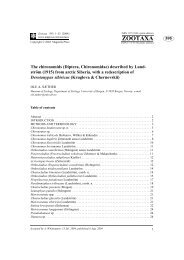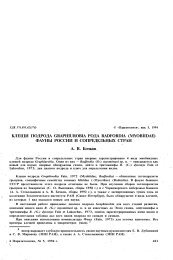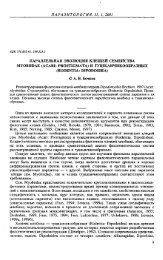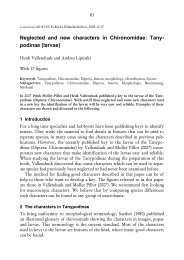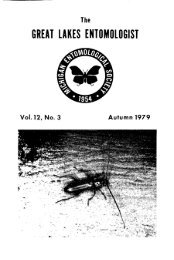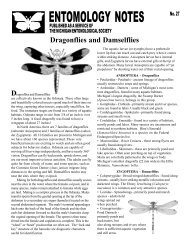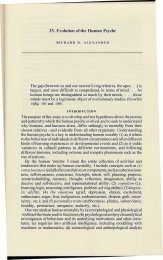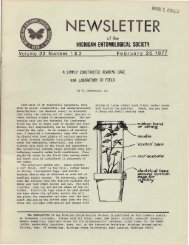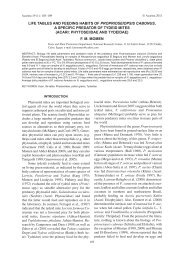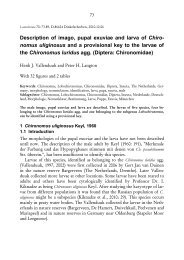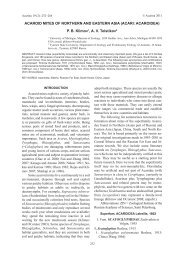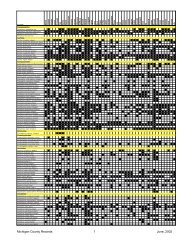Chironomus newsletter on Chironomidae research 22
Chironomus newsletter on Chironomidae research 22
Chironomus newsletter on Chironomidae research 22
You also want an ePaper? Increase the reach of your titles
YUMPU automatically turns print PDFs into web optimized ePapers that Google loves.
Discussi<strong>on</strong><br />
Figure 3. Abundance of Parochlus steinenii remains (per gram dry weight) in a sediment<br />
core from Limnopolar Lake as a functi<strong>on</strong> of depth. Also shown are the abundance of tephra<br />
shards and a qualitative estimate of the amount of dead moss present in the sediment. The<br />
time span covered by the sediment core is probably of the order of 2000 years.<br />
The occurrence of remains of Parochlus steinenii<br />
at nearly all depths sampled within the sediment<br />
core indicates that the species was present<br />
throughout the time the sediment was deposited.<br />
While the precise time interval the core represents<br />
cannot be determined, it is certain that the<br />
chir<strong>on</strong>omid has been present <strong>on</strong> Byers Peninsula<br />
for an extended period, and that the suggesti<strong>on</strong><br />
that the species was introduced by whalers can be<br />
almost certainly refuted. The observed<br />
distributi<strong>on</strong> within the sediment is c<strong>on</strong>sistent with<br />
the c<strong>on</strong>clusi<strong>on</strong>s of Allegrucci et al. (2005), who<br />
suggested an ancient origin for this species and<br />
therefore the presence of glacial refugia either <strong>on</strong><br />
the Antarctic Peninsula or within the South<br />
Shetland Islands. Recogniti<strong>on</strong> of similar glacial<br />
refugia across Antarctica is increasing (C<strong>on</strong>vey et<br />
al. 2008)<br />
The distributi<strong>on</strong> of the remains in the core gives<br />
some indicati<strong>on</strong> of the habitat preferences of the<br />
species: it appears to be more abundant when<br />
significant moss growth occurs in the lake. Toro<br />
et al. (2007) reported that Parochlus steinenii was<br />
most likely to be present in Livingst<strong>on</strong> Island<br />
20<br />
lakes that also c<strong>on</strong>tained benthic mosses, which is<br />
c<strong>on</strong>sistent with this c<strong>on</strong>clusi<strong>on</strong>. Abundance<br />
appears to be negatively impacted by depositi<strong>on</strong><br />
of tephra from nearby volcanic erupti<strong>on</strong>s, which<br />
would smother food sources. Similar observati<strong>on</strong>s<br />
have been made during the study of a Chilean<br />
lake impacted by tephral depositi<strong>on</strong> (Urrutia et al.<br />
2007). However, it may also be that these<br />
apparent correlati<strong>on</strong>s are artefacts stemming from<br />
changes in sedimentati<strong>on</strong> rates as a result of<br />
tephra and other volcanic inputs. The absence of<br />
larval head capsules in the sediment is surprising,<br />
as larvae inhabit Limnopolar Lake (Toro et al.<br />
2007). The c<strong>on</strong>clusi<strong>on</strong> to be drawn from this<br />
observati<strong>on</strong> is that the head capsules of Parochlus<br />
steinenii are not preserved in the sediment.<br />
Acknowledgements<br />
We thank M. Toro for collecting the core and<br />
kindly providing the sediments for this <strong>research</strong>,<br />
P. C<strong>on</strong>vey for c<strong>on</strong>firming the identity of the<br />
chir<strong>on</strong>omid remains, and the Australian Institute<br />
for Nuclear Science and Engineering for funding<br />
the attempts at dating the sediment core (Grants<br />
05063 and 07066). The Ministerio de Educación<br />
y Ciencia (Spain) also funded parts of this work



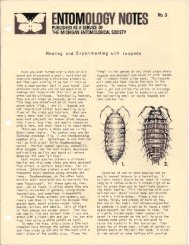
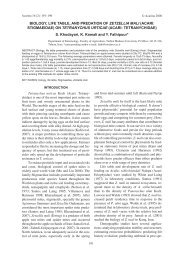
![Williamsonia 1-1 [v4.0] (DR) - Insect Division - University of Michigan](https://img.yumpu.com/18248489/1/190x245/williamsonia-1-1-v40-dr-insect-division-university-of-michigan.jpg?quality=85)
